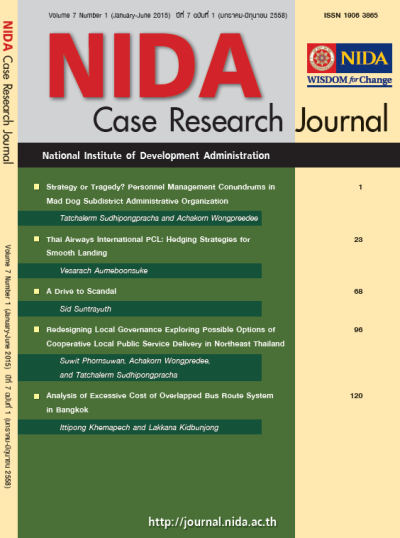Redesigning Local Governance Exploring Possible Options of Cooperative Local Public Service Delivery in Northeast Thailand
Keywords:
Thai Local Government, Public Service Delivery, Interlocal Cooperation, ConsolidationAbstract
Decentralization of public service functions to a local level is regularly seen as a reform approach that increases the quality of democratic governance and public services. Yet, despite the promises of decentralization, local government units in both developed and developing countries are under constant pressure to provide their constituents with essential public services that are effective, efficient, and equitable. In the developed countries, changing demographic patterns and long-term economic stagnation have eroded local tax bases and consequently diminished local government resources. An often recommended remedy is a reorganization of local service delivery, including annexation, consolidation, and intercity collaborative agreement. Apart from the demographic and economic changes, local authorities in Thailand and other developing countries must also cope with the poorly designed administrative systems in which jurisdictional boundaries have been arbitrarily drawn and local revenue-generating power strictly limited.
This case provides a description of the problems facing two adjacent rural municipalities in northeast Thailand—Nam Pong and Lam Nam Pong municipalities. Nam Pong Municipality—albeit smaller in land area and local tax base—have and provide more infrastructure facilities for its residents, as well as a significant number of Lam Nam Pong residents. Even though this situation has not been a serious drain on Nam Pong Municipality’s coffers over the past few decades, increased public demand for services and rising costs of service delivery and management are likely to destabilize the municipality’s finances. In dealing with this future fiscal challenge, the Nam Pong mayor—the focal manager in this case—has to explore all the politically, economically, and legally viable alternatives for delivering public services.
This case is designed to enhance students’ understanding of the complexity confronting Thai local jurisdictions, as they struggle to optimize resource utilization and public service performance to serve their constituents. These complex factors include, but are not limited to, political opposition, legal and regulatory constraints, and increasingly vocal and interconnected citizens. In this case, students are required to identify alternative service delivery models, analyze the strengths and weaknesses of each model, and provide the focal manager with a set of proposed actions.




